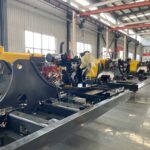Introduction
Excavator shovels are essential tools used in construction and excavation projects. These powerful machines have revolutionized the way we dig, move, and lift heavy materials. With advancements in technology and engineering, the modern excavator shovel has become more efficient, versatile, and safer to operate. In this article, we will explore the modern rules of excavator shovel operation, maintenance, and safety.
Table of Contents
- Understanding the Basics of Excavator Shovels
- Choosing the Right Excavator Shovel
- Operating an Excavator Shovel
- Safety Precautions
- Controls and Functions
- Digging Techniques
- Maintenance and Care for Excavator Shovels
- Daily Inspections
- Lubrication and Fluid Checks
- Component Replacement
- Advanced Features and Technologies in Excavator Shovels
- GPS and Machine Control Systems
- Attachments and Accessories
- Excavator Shovel Safety Practices
- Site Preparation and Risk Assessment
- Personal Protective Equipment (PPE)
- Emergency Procedures
- The Future of Excavator Shovels
- Conclusion
- FAQs
Understanding the Basics of Excavator Shovels

Excavator shovels are powerful machines used in construction and excavation projects. These machines are designed to dig, move, and lift large quantities of soil, rocks, and other materials. By understanding the basics of excavator shovels, you can gain insight into their structure and functionality.
At its core, an excavator shovel consists of several key components. The primary components include the boom, stick, bucket, and the rotating platform known as the house. The boom is the long, horizontal arm that extends from the machine’s body, providing reach and lifting capability. Attached to the end of the boom is the stick, which allows for further extension and contraction. The bucket, typically equipped with teeth or other digging tools, is connected to the stick and is responsible for excavating and scooping up materials.
The house, situated at the base of the boom, enables the excavator shovel to rotate 360 degrees. This rotation provides versatility and flexibility, allowing the operator to easily maneuver the machine and deposit materials in desired locations.
To operate an excavator shovel effectively, it is essential to understand the controls and functions. Modern excavators are equipped with user-friendly controls that allow operators to manipulate the machine with precision. These controls include joysticks, pedals, and switches that govern various movements and operations. Familiarizing yourself with these controls and their corresponding functions is vital for efficient and accurate operation of the excavator shovel.
Moreover, different digging techniques can be employed based on the specific requirements of the project. Techniques such as trenching, sloping, and benching are commonly used in excavation projects. Each technique requires skill and understanding of the machine’s capabilities. Factors such as soil conditions, excavation depth, and the desired outcome should be taken into consideration when selecting the appropriate digging technique.
By grasping the fundamentals of excavator shovel operation, including the understanding of its components, controls, and digging techniques, you can effectively utilize this powerful machine to accomplish a wide range of construction and excavation tasks.
Choosing the Right Excavator Shovel
Selecting the appropriate excavator shovel for a specific project is crucial for optimal performance and productivity. Factors to consider include the size and depth of the excavation, soil conditions, and the required reach and lifting capacity. Consulting with experts and considering the machine’s specifications and capabilities is essential in making the right choice.
Operating an Excavator Shovel
Safety Precautions
Prioritizing safety is of utmost importance when operating an excavator shovel. Operators should undergo proper training and certification to ensure they are well-versed in safe operating practices. They should also adhere to site-specific safety regulations, wear appropriate personal protective equipment (PPE), and conduct pre-operation inspections.
Controls and Functions
Modern excavator shovels are equipped with user-friendly controls that allow operators to manipulate the machine with precision. Understanding the functions of each control, such as the joystick, pedals, and switches, is essential for smooth and efficient operation.
Digging Techniques
Mastering various digging techniques helps optimize the excavator shovel’s performance. Techniques like trenching, sloping, and benching require skill and experience. It is essential to understand the soil conditions, excavation depth, and the machine’s limitations to perform these techniques effectively.
Maintenance and Care for Excavator Shovels
To ensure the longevity and reliability of an excavator shovel, regular maintenance and care are crucial.
Daily Inspections
Performing daily inspections before operating the machine is essential. These inspections involve checking fluid levels, inspecting the undercarriage, tracks, and hydraulic components, and identifying any signs of wear or damage.
Lubrication and Fluid Checks
Proper lubrication and fluid checks are necessary to keep the excavator shovel running smoothly. Regularly greasing the joints, checking hydraulic fluid levels, and changing the filters at recommended intervals are some of the maintenance tasks that need attention.
Component Replacement
Over time, certain components of an excavator shovel may wear out and require replacement. Keeping an eye on wear parts like teeth, tracks, and hydraulic hoses ensures optimal performance and minimizes downtime.
Advanced Features and Technologies in Excavator Shovels
Excavator shovels have seen significant advancements in technology and engineering, leading to the incorporation of advanced features and technologies that enhance their performance and efficiency. These innovations have revolutionized the way excavator shovels are used in construction and excavation projects.
One of the notable advancements in excavator shovels is the integration of GPS and machine control systems. These systems provide real-time data and precise positioning information, allowing operators to achieve accurate and efficient digging. GPS technology enables the excavator shovel to determine its exact location, while machine control systems use this information to guide the machine’s movements and ensure precise excavation according to the desired specifications. This level of accuracy minimizes errors, reduces material wastage, and improves overall productivity.
Additionally, excavator shovels now offer a wide range of attachments and accessories that enhance their versatility. Hydraulic breakers, grapples, augers, and other specialized attachments can be easily mounted onto the machine, enabling it to perform various tasks beyond traditional digging. These attachments expand the capabilities of excavator shovels, allowing them to tackle tasks such as demolition, material handling, and drilling. The ability to quickly switch between different attachments makes the excavator shovel a highly adaptable and efficient tool for diverse projects.
Furthermore, advancements in hydraulic systems have significantly improved the performance and efficiency of excavator shovels. Modern hydraulic systems provide enhanced control, allowing for smoother and more precise movements. This translates to increased digging power and improved handling of heavy loads. The improved efficiency of hydraulic systems also contributes to reduced fuel consumption, resulting in cost savings and reduced environmental impact.
The integration of telematics and remote monitoring systems is another notable advancement in excavator shovels. These systems enable remote monitoring of the machine’s performance, productivity, and maintenance needs. Real-time data on fuel consumption, operating hours, and maintenance schedules can be accessed, allowing for proactive maintenance planning and optimizing machine utilization. This technology facilitates better equipment management and helps prevent unexpected breakdowns, minimizing downtime and maximizing productivity.
Excavator shovels are continuously evolving, with ongoing research and development aimed at further improving their features and performance. Future advancements may include even more advanced automation capabilities, increased fuel efficiency, improved operator comfort and safety features, and integration with emerging technologies such as artificial intelligence and machine learning.
GPS and Machine Control Systems
GPS and machine control systems have revolutionized excavator shovel operations. These systems provide real-time data on the machine’s position, grade, and depth, allowing for precise and accurate digging.
Attachments and Accessories
Excavator shovels can be fitted with various attachments and accessories to perform specialized tasks. Attachments like hydraulic breakers, grapples, and augers increase the versatility of the machine, enabling it to tackle a wide range of projects.
Excavator Shovel Safety Practices

Safety should always be a top priority when operating an excavator shovel. Adhering to proper safety practices ensures the well-being of operators, workers in the vicinity, and the overall success of the project. By implementing a comprehensive set of safety practices, potential risks and accidents can be minimized or avoided altogether.
Before starting any excavation project, thorough site preparation and risk assessment are essential. Conducting a site survey helps identify potential hazards such as underground utilities, unstable ground conditions, or overhead obstructions. This information enables operators to plan and execute the excavation safely, taking appropriate precautions to mitigate risks.
Personal protective equipment (PPE) plays a crucial role in excavator shovel safety. Operators should wear the necessary protective gear, including hard hats, high-visibility vests, safety glasses, steel-toed boots, and ear protection. PPE helps safeguard against potential head injuries, visibility issues, foot injuries, and hearing damage.
Regular training and certification programs are imperative for excavator shovel operators. These programs provide operators with the knowledge and skills required to safely operate the machine. Proper training ensures operators understand the machine’s controls, functions, and safe operating procedures, minimizing the risk of accidents due to operator error.
Performing pre-operation inspections is a vital safety practice. Before starting the machine, operators should conduct a thorough inspection of the excavator shovel. This includes checking the condition of the tracks, hydraulic components, and safety features. Any signs of wear, damage, or malfunction should be addressed promptly to avoid potential accidents during operation.
Maintaining clear communication on the worksite is crucial for safety. Operators should establish effective communication channels with ground workers, signalpersons, and other personnel involved in the project. Clear hand signals, radio communication, or other established protocols ensure that everyone is aware of the excavator shovel’s movements and actions, reducing the risk of accidents and collisions.
Emergency procedures should be in place and communicated to all personnel on the worksite. Operators should be trained in emergency shutdown procedures and evacuation plans. In the event of an emergency, swift and coordinated actions can prevent injuries and minimize potential damage.
Regular maintenance and inspections of the excavator shovel are essential to ensure its safe operation. Following the manufacturer’s recommended maintenance schedule and conducting routine checks on hydraulic systems, tracks, and safety features help identify potential issues before they become hazardous. Timely maintenance and repairs contribute to the overall safety and longevity of the machine.
Lastly, fostering a culture of safety on the worksite is paramount. Employers should provide ongoing safety training, encourage open communication about safety concerns, and promote a proactive approach to safety among all workers. Safety should be a shared responsibility, and everyone involved in the project should actively participate in creating a safe work environment.
Site Preparation and Risk Assessment
Before starting any excavation project, proper site preparation and risk assessment should be conducted. Identifying potential hazards, marking underground utilities, and implementing safety barriers are crucial steps to ensure a safe work environment.
Personal Protective Equipment (PPE)
Operators and other personnel working in the vicinity of an excavator shovel should wear appropriate PPE. This includes hard hats, high-visibility vests, safety glasses, steel-toed boots, and ear protection.
Emergency Procedures
Being prepared for emergencies is vital. Operators should be familiar with emergency shutdown procedures, evacuation plans, and first aid protocols. Regular drills and training sessions contribute to a safer working environment.
The Future of Excavator Shovels
Excavator shovels continue to evolve with advancements in technology and engineering. The future holds exciting possibilities, such as further automation, enhanced fuel efficiency, and improved safety features. Continuous innovation will shape the future of these indispensable construction machines.
Conclusion
The modern rules of excavator shovel operation prioritize safety, efficiency, and versatility. By understanding the basics, adhering to safety practices, performing regular maintenance, and embracing technological advancements, operators can make the most of these powerful machines. Excavator shovels play a vital role in the construction industry, enabling us to undertake challenging projects with ease and precision.
FAQs
1. How do I choose the right excavator shovel for my project?
To choose the right excavator shovel, consider factors such as the size and depth of the excavation, soil conditions, and required reach and lifting capacity. Consulting with experts and assessing the machine’s specifications will help in making an informed decision.
2. What safety precautions should I take when operating an excavator shovel?
Safety precautions when operating an excavator shovel include undergoing proper training, following site-specific regulations, wearing personal protective equipment (PPE), and conducting pre-operation inspections.
3. How often should I perform maintenance on an excavator shovel?
Regular maintenance is essential for an excavator shovel’s longevity. Daily inspections, lubrication, fluid checks, and timely replacement of worn components should be part of a routine maintenance schedule.
4. What are some advanced features in modern excavator shovels?
Modern excavator shovels are equipped with advanced features like GPS and machine control systems, which provide real-time data for precise digging. They can also be fitted with various attachments to perform specialized tasks.
5. What does the future hold for excavator shovels?
The future of excavator shovels involves further automation, improved fuel efficiency, and enhanced safety features. Continuous innovation will shape the future of these machines, making them even more efficient and reliable.







-150x150.webp)
